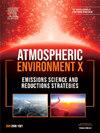Emissions from fuel-operated heaters in battery-electric buses
IF 3.4
Q2 ENVIRONMENTAL SCIENCES
引用次数: 0
Abstract
Battery-electric buses have become more common in the urban environment. At low ambient temperatures the energy consumption due to heating of the passenger and driving compartment can be significant, and to preserve the range of the battery fuel-operated heaters can be used. The legislation regarding these heaters is less stringent compared to engine exhaust emission legislation e.g., Euro VI, and knowledge about these emissions is scarce. In this study, emissions from 34 fuel-operated heaters, running on hydrotreated vegetable oil (HVO), in battery-electric buses from an in-use bus fleet have been characterised both regarding gaseous (total hydrocarbon (THC) and nitrogen oxides (NOx)) and particle pollutants (particle number (PN), particle mass (PM), black carbon (BC) and size) during real-world dilution. The median PM and PN emissions varied between 0.96 and 8.4 mg (kg fuel)−1 and 4.4–127 × 1013 # (kg fuel)−1 for the heater types studied. Additionally, the significance of the heater emissions compared to engine exhaust emissions was analysed.
电动巴士燃油加热器的排放
纯电动公交车在城市环境中变得越来越普遍。在较低的环境温度下,由于乘客和驾驶隔间的加热而消耗的能量可能是显著的,并且可以使用电池燃料操作加热器来保持范围。与发动机废气排放法规(如欧六)相比,有关这些加热器的法规没有那么严格,而且有关这些排放的知识很少。在这项研究中,来自正在使用的公交车队的34个燃料加热器,使用加氢处理植物油(HVO),在实际稀释过程中,对气体(总碳氢化合物(THC)和氮氧化物(NOx))和颗粒污染物(颗粒数(PN)、颗粒质量(PM)、黑碳(BC)和大小)的排放进行了表征。所研究的加热器类型的PM和PN排放中位数在0.96 - 8.4 mg (kg燃料)−1和4.4-127 × 1013 # (kg燃料)−1之间变化。此外,还分析了加热器排放与发动机尾气排放的关系。
本文章由计算机程序翻译,如有差异,请以英文原文为准。
求助全文
约1分钟内获得全文
求助全文
来源期刊

Atmospheric Environment: X
Environmental Science-Environmental Science (all)
CiteScore
8.00
自引率
0.00%
发文量
47
审稿时长
12 weeks
 求助内容:
求助内容: 应助结果提醒方式:
应助结果提醒方式:


